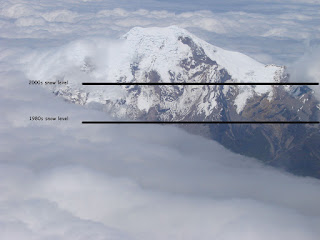 When you fly from Quito to the Amazon in Ecuador you pass by Ecuador's highest peak, Chimborazo (20,702 feet). Global warming has eliminated much of the snow pack at the top.
When you fly from Quito to the Amazon in Ecuador you pass by Ecuador's highest peak, Chimborazo (20,702 feet). Global warming has eliminated much of the snow pack at the top.I had a chance to talk to an underwater photographer who's been flying that route for decades, noticing global warming's effect on the snow pack of the mountain. He's noticed a visible retreat he thinks is due to global warming of the snow line about the distance marked in the picture above.
Other data has supported the drastic disappearance of snow and ice in the Andes caused by global warming.
Here's other evidence that the ice in the Andes is disappearing:
* Qori Kalis, a glacier in Peru retreat rate was 13 feet/year in the 60s. Global warming has caused it to accelerate to over 100 feet/year (estimated) today.
* Quelccaya ice cap in the Southern Andes has shrunk by 20 percent since the 60s, and, it is believed the cause is global warming.
* The number of glaciers in the Venezuelan Andes has gone down from 6 to 2 since the 70s, possibly due to global warming.
* Temperatures in the Andes have warmed by .6 F since the 70s--believed to be caused by global warming.
* The ice cap on the peak of Cotacachi in Eucador, which up until a few years ago had been there for eons, has melted away.
* Global warming is believed to cause 80 percent of the glaciers in Bolivia to melt.
If anyone in the United States congress dares to say that global warming does not exist, he should be impeached on the spot.
Photograph was taken by Matt Bamberg (that would be me) earlier this year, copyright 2007.


 2 ... 2 ...
2 ... 2 ...
0 comments:
Post a Comment